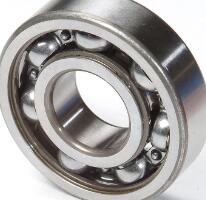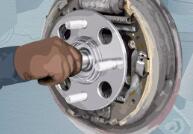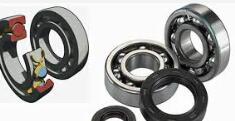Ball bearing vs Wheel bearing, which is better?
Are you trying to decide between a ball bearing and a wheel bearing for your next application?
Look no further! This guide provides an easy-to-understand breakdown of the differences between ball bearings and wheel bearings to help you choose the right bearing for your needs!
When it comes to automotive parts, there's no denying that ball bearings and wheel bearings both have their uses.
But which one should you use for your car? Let's take a look at the differences between ball bearings and wheel bearings, so you can make an informed decision.
Ball bearings are different from wheel bearings in that they allow for smoother rotation and reduced friction.
Ball bearings use small steel balls to reduce friction, while wheel bearings use a set of hardened steel or ceramic balls to provide support.
Ball bearings are usually found in applications that require higher speeds and/or loads, such as in roller sports, fishing reels, and machine tools.
Wheel bearings are typically used in more static applications, such as car axles and factory machinery.
Ball bearings are also more difficult to install and maintain than wheel bearings.
Ball bearings require precise alignment and lubrication, while wheel bearings are simply inserted into the housing with a bit of force.
Despite the extra complexity, ball bearings provide superior performance over wheel bearings in some applications.
They are more durable and can handle higher loads with greater precision, making them an ideal choice for high-performance applications.
This article discusses the features of ball bearings and wheel bearings.
The next section includes their structure, applications, advantages, and disadvantages.
What is a ball bearing and what is a wheel bearing?
A ball bearing is a type of rolling-element bearing that uses balls to maintain the separation between the moving parts of the bearing.
The purpose of a ball bearing is to reduce rotational friction and support radial and axial loads.
It achieves this by using at least two races to contain the balls and transmit the load through the balls.
In most applications, one race is stationary and the other is attached to the rotating assembly. As one of the oldest forms of bearings, ball bearings have been in use since at least the 17th century.
Today, they are widely used in cars, bicycles, home appliances, power tools, and many other products.
Additionally, ball bearings are found in almost every machine with movable parts.
A wheel bearing is a component that is part of a vehicle's wheel assembly.
It consists of an outer and inner ring, with steel balls or rollers in between the two rings.
The purpose of the wheel bearing is to allow the wheel to rotate freely while supporting the weight of the vehicle and providing smooth operation over rough terrain or bumps on the road.
Wheel bearings are typically located at each corner of a vehicle's suspension system, allowing for even distribution of the vehicle's weight and providing stability when cornering.
For a wheel bearing to function properly, it must be well-maintained and lubricated.
Main features of ball bearing

Structure
1.Components
A ball bearing typically consists of four main components: an outer ring, an inner ring, balls, and a cage.
The outer ring is a circular metal component that helps keep the bearing stable while it is in motion.
The inner ring is slightly smaller than the outer and also made of metal.
The balls are placed between the two rings and are usually composed of steel or ceramic.
The cage acts as a guide for the balls, helping to maintain their spacing and keep them evenly distributed within the assembly.
All of these parts work together to enable smooth rotation at high speeds with minimal friction or vibration. Ball bearings have many applications, from powering bicycles to driving heavy machinery in factories and manufacturing plants.
They can be found almost everywhere in everyday life!
2.Operation
A ball bearing is a type of rolling-element bearing that uses balls to maintain the separation between the moving parts of the bearing.
The purpose of a ball bearing is to reduce rotational friction and support radial and axial loads.
It achieves this by using at least two races to contain the balls and transmit the loads through the balls.
In most applications, one race is stationary and the other is attached to the rotating assembly (e.g., a hub or shaft).
As one of the races rotates it causes the balls to rotate as well, which reduces friction between moving parts by providing lubricated surfaces for them to roll against each other.
Ball bearings are used in a wide variety of applications from inline skate wheels to computer hard drives, and they come in a variety of sizes and different materials.
Ball bearings are most commonly made from chrome steel and other materials such as ceramic or plastic.
Applications
1.Motors
Ball bearings are essential components of motors. These devices help to reduce friction between moving parts, allowing the motor to run smoother and more efficiently.
This leads to reduced energy consumption, which in turn results in cost savings for businesses that rely on motors as part of their operations.
In addition, by reducing wear and tear on the motor's components, ball bearings can also extend their lifetime, further decreasing maintenance costs associated with motors.
Ball bearings are found in a variety of applications across industries such as automotive, aerospace, and manufacturing.
They provide reliable performance over long periods and are relatively easy to install and maintain.
Therefore, they remain an important component of any motor used in these industries today.
2.Bicycles
Ball bearings can also be found on bicycles. Bicycle ball bearings typically take the form of cartridge bearings, which usually contain both an inner and an outer race.
These races house a series of small cylindrical balls that allow the wheel to rotate easily with minimal friction between the spoked wheel and axle.
Cartridge bearing assemblies also have a seal surrounding them, which prevents water and dirt from entering and damaging the bearings.
By utilizing bicycle ball bearings, cyclists can enjoy smooth, reliable rides on their bikes without having to worry about too much drag or wear over time.
Additionally, because of their small size, ball bearings require little maintenance and are inexpensive and easy to replace if necessary.
3.Robotics
Ball bearings are essential components in robotics, as they help reduce friction and provide support during motion.
In robotic joints, ball bearings act as the link between two connected parts and enable smoother movement along a desired trajectory.
They also support additional loads that may be imposed by other components of the robot.
Ball bearings are designed to offer low rolling resistance and enable precision movement, making them an ideal choice for robotic hardware applications.
Advantages
1.High load-bearing capacity
Ball bearings are an important type of bearing that offer high load-bearing capacity due to their spherical shape and rolling motion.
This makes them ideal for applications where heavy loads need to be supported, such as motors, transmissions, hubs, and machinery.
Additionally, ball bearings have low friction coefficients which make them more efficient than typical sliding or plain bearings.
The reduced friction also ensures smoother and quieter operation of the system.
Ball bearing technology is one of the most reliable types of bearing available on the market today and can be used with confidence in a variety of industrial sectors.
Furthermore, they are relatively inexpensive when compared to other types of bearings on the market and require minimal maintenance over time; this makes them cost-effective choices for many applications.
2.Low friction
Ball bearings are a popular choice for many applications due to their low friction.
The design of the bearing reduces the contact between it and the surfaces that it is in contact with, resulting in low rolling resistance.
This helps to reduce energy consumption and increase the efficiency of machinery that use ball bearings.
The low friction also extends the lifespan of components as there is less wear on them from prolonged use.
Additionally, these bearings require minimal maintenance for continued operation and can be used in high-speed applications without jeopardizing performance or reliability.
Moreover, ball bearings come in a variety of sizes and designs to suit any application, making them an ideal choice for many industrial projects.
3.Durable
Ball bearings are highly durable and can withstand high levels of pressure and friction for extended periods.
This makes them ideal for a wide range of industrial applications, from automotive parts to machining tools.
Ball bearings can operate in a variety of temperature ranges and can be used with various types of lubricants.
Their reliability makes them an essential component in any machinery or equipment requiring smooth operation and high performance.
Furthermore, ball bearings require minimal maintenance as they do not corrode easily and require very little lubrication.
Due to their low cost, ball-bearing assemblies are easy to replace when needed without breaking the bank.
All these advantages make ball bearings an ideal choice for many industries where durability is paramount.
Main features of wheel bearing

Structure
1.Components
Wheel bearings typically consist of four main components: an inner race, an outer race, rolling elements, and a retainer.
The inner race is fitted onto the axle shaft while the outer race is pressed into the wheel hub or spindle.
Rolling elements such as steel balls or rollers are inserted between them to help absorb axial, radial, and torque loads.
The retainer holds these rolling elements in place to prevent any unwanted movement.
All four parts work together to reduce friction and enable smooth rotation between the wheel hub and axle shaft.
As wheel bearings are subject to high-speed rotation, they must be regularly inspected for signs of wear or damage and replaced accordingly.
Failing to do so can lead to accelerated wear, increased noise levels, and ultimately wheel bearing failure.
Wheel bearings are an important component of vehicle safety and should only be serviced by a qualified mechanic to ensure they are in good condition.
2.Operation
Wheel bearings are an essential component of any vehicle, as they support the wheels and enable them to rotate freely.
The wheel bearing consists of two rings, the inner ring, and the outer ring, both of which are held together with a series of small metal balls or rollers.
The inner ring is attached to the hub or axle, while the outer ring is connected to the wheel itself.
As the wheel rotates, these metal balls move back and forth in their tiny pockets allowing for a smooth rotation without too much friction or vibration.
This ensures that your car moves forward with minimal effort and noise generated by rotating parts.
Applications
1.Automobiles
Wheel bearings are an essential component of automobiles, as they provide efficient and smooth rolling motion for wheel axles.
They support the weight of the vehicle, allowing it to move with minimal friction.
Wheel bearings reduce wear on other parts of the car, such as tires and suspension components, by providing a lubricated surface between moving parts.
Additionally, wheel bearings help minimize vibration from road irregularities which can affect the comfort of occupants in the vehicle.
As such, wheel bearing maintenance is important for ensuring the safe and reliable operation of automobiles.
Regular inspections should be conducted to check for signs of wear or damage caused by extreme temperature changes or regular use.
Repairing or replacing worn wheel bearings is necessary to ensure that your automobile performs optimally.
2.Heavy machinery
Wheel bearings are essential components of heavy machinery, as they enable the wheels to spin freely and efficiently.
Without them, it would be difficult for machines to move and function properly. Wheel bearing assemblies often consist of two races that hold the ball bearings in place within a metal housing unit.
As the wheel is rotated, these bearings reduce friction between the inner and outer race, allowing for smooth rotation.
Furthermore, due to their structure, wheel bearings can handle high levels of force from the axle shafts with minimal wear and tear over time.
This makes them an ideal choice for applications requiring robustness and reliability such as heavy machinery.
Many heavy machinery manufacturers rely on wheel bearing assemblies for their vehicles.
3.Trailers
Wheel bearings are essential components of trailers, as they help the wheel to rotate smoothly.
They also reduce friction between the wheel and axle, which makes towing and maneuvering the trailer easier.
Additionally, wheel bearings help to spread the load of the trailer evenly on its axles, reducing wear on other parts of the trailer and helping in absorbing shock from bumps or uneven terrain.
They also provide support for the wheels while they are turning. Without proper wheel bearings, trailers may experience significant damage over time.
Advantages
1.Withstand heavy loads
Wheel bearings are an essential part of any vehicle, providing stability, improved performance, and comfort.
They also provide several advantages compared to other bearing types, such as being able to withstand heavy loads.
This is particularly beneficial for vehicles that are subject to frequent loading or repetitive movement, as wheel bearings can handle greater weights than other types of bearings.
2.Smooth operation
Wheel bearings are a vital component in the smooth operation of any vehicle.
They provide a rotational force that allows the wheels to turn without resistance, enabling smoother steering and providing better control when driving.
Additionally, they reduce the amount of friction between components, which leads to improved fuel efficiency and longer tire life.
3.Longevity
Wheel bearings are essential components of any vehicle, as they help provide a smooth and quiet ride.
One of the primary advantages of wheel bearings is their longevity.
Wheel bearings are designed to last for years with proper maintenance and care.
In addition, due to their robust design, wheel bearings do not require frequent replacement like other car parts.
This makes them an economical and reliable choice for vehicle owners.
Furthermore, wheel bearings reduce friction between the wheel and axle, allowing them to rotate freely without excessive wear.
Comparison between Ball Bearings and Wheel Bearings

1.Load-bearing capacity
Ball bearings are designed to carry substantially lighter loads than wheel bearings, due to the contained rolling elements being smaller and having a lower load rating.
Wheel bearings can carry significantly higher loads due to their larger diameter, the greater number of rolling elements, and the increased contact area between the components.
All other factors being equal, such as bearing geometry and material properties, a wheel bearing will always have greater load-bearing capacity than a ball bearing.
2.Friction
Wheel bearings are designed to support the weight of a vehicle, as well as provide smooth and efficient operation.
Ball bearings, on the other hand, are used in applications where both radial and axial loads must be accommodated.
As such, ball bearings feature higher friction and require lubrication for optimal performance.
In comparison, wheel bearings are self-lubricating and require little maintenance, making them ideal for automotive applications.
3.Durability
The durability of a ball bearing is significantly greater than that of a wheel bearing.
Ball bearings have been used for decades in industrial and automotive applications, but only recently have they become the standard choice for many high-performance vehicles due to their superior strength and durability.
The rolling elements of a ball bearing are made from hardened steel which allows them to withstand up to ten times more stress than traditional wheel bearings.
Additionally, ball bearings have low rolling resistance and require very little lubrication
4.Cost
The cost of ball bearings and wheel bearings can vary depending on a range of factors including size, type, and quality.
For example, ball bearings are generally more expensive than wheel bearings due to their precision engineering and higher production costs.
Ball bearings are also typically designed for high-speed applications, which can increase their cost in comparison with wheel bearings.
Conclusion
Ball bearings and wheel bearings are two essential components that are used in many machines.
In terms of overall performance, wheel bearings offer superior load-carrying capacity compared to ball bearings due to their higher radial load capacity.
Additionally, wheel bearings can be used on all types of vehicles, providing a more reliable, long-term solution for vehicle owners.
Ball bearings are more commonly used in applications that require a lighter load, such as electric motors and pumps.





